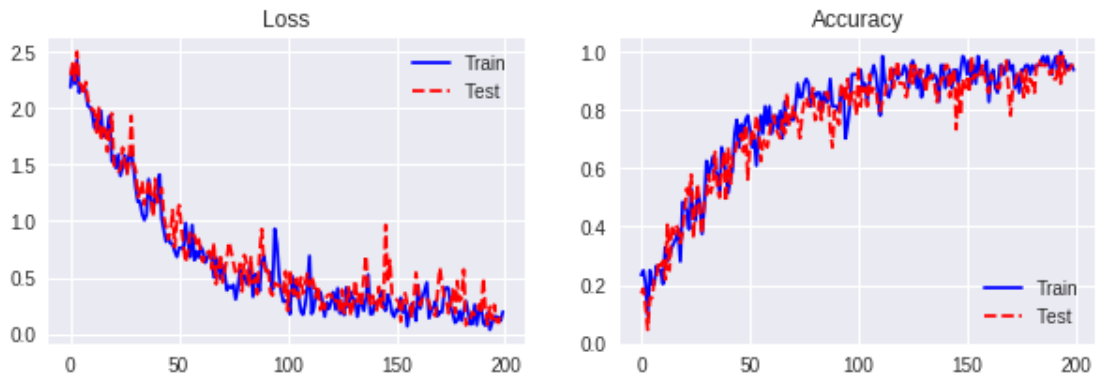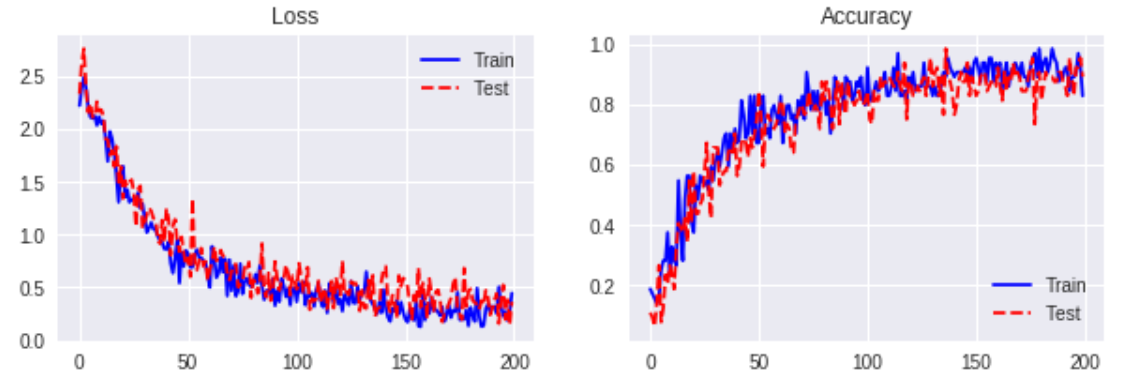ポイント
- LSTMをベースに Weight Normalization を実装。MNIST 手書き数字データでパフォーマンスを検証。
- Weight Normalization の効果を確認。
- Gradient Clipping の効果は今後、再検証。
レファレンス
1. Weight Normalization: A Simple Reparameterization to Accelerate Training of Deep Neural Networks
検証方法
-
MNIST手書き数字データを使用。一層目の LSTM に Weight Normalization を適用。
-
Base model( Normalization なし)と比較。
-
Weight Normalization
y = \phi(w \cdot x + b) \\
w = \frac{g}{||v||}v \\
データ
MNIST handwritten digits
from tensorflow.examples.tutorials.mnist import input_data
mnist = input_data.read_data_sets('***/mnist', \
one_hot = True)
検証結果
数値計算例:
- n_units = 100
- learning_rate = 0.1
- batch_size = 64
Weight Normalization ( no gradient clipping )

Weight Normalization ( clipped-by-norm, 0.5 )

< br>
サンプルコード
# Weight Normalization
def inference(self, x, length, n_in, n_units, n_out, \
batch_size, forget_bias):
x = tf.reshape(x, [-1, length, n_in])
h = tf.zeros(shape = [batch_size, n_units], \
dtype = tf.float32)
c = tf.zeros(shape = [batch_size, n_units], \
dtype = tf.float32)
list_h = []
list_c = []
with tf.variable_scope('lstm'):
init_norm = tf.truncated_normal_initializer(mean = \
0.0, stddev = 0.05, dtype = tf.float32)
init_constant1 = tf.constant_initializer(value = \
0.0, dtype = tf.float32)
init_constant2 = tf.constant_initializer(value = \
0.1, dtype = tf.float32)
v_x = tf.get_variable('w_x', shape = [n_in, n_units \
* 4], initializer = init_norm)
g_x = tf.get_variable('g_x', shape = [n_units * 4], \
initializer = init_constant2)
v_h = tf.get_variable('w_h', shape = [n_units, \
n_units * 4], initializer = init_norm)
g_h = tf.get_variable('g_h', shape = [n_units * 4], \
initializer = init_constant2)
b = tf.get_variable('b', shape = [n_units * 4], \
initializer = init_constant1)
for t in range(length):
v_norm_x = tf.nn.l2_normalize(v_x, axis = [0])
w_x = g_x * v_norm_x
t_x = tf.matmul(x[:, t, :], w_x)
v_norm_h = tf.nn.l2_normalize(v_h, axis = [0])
w_h = g_h * v_norm_h
t_h = tf.matmul(h, w_h)
i, f, o, g = tf.split(tf.add(tf.add(t_x, t_h), b), \
4, axis = 1)
i = tf.nn.sigmoid(i)
f = tf.nn.sigmoid(f + forget_bias)
o = tf.nn.sigmoid(o)
g = tf.nn.tanh(g)
c = tf.add(tf.multiply(f, c), tf.multiply(i, g))
h = tf.multiply(o, tf.nn.tanh(c))
list_h.append(h)
list_c.append(c)
with tf.variable_scope('pred'):
w = self.weight_variable('w', [n_units, n_out])
b = self.bias_variable('b', [n_out])
y = tf.add(tf.matmul(list_h[-1], w), b)
y = tf.nn.softmax(y, axis = 1)
return y
def training(self, loss, learning_rate, clip_norm):
optimizer = tf.train.AdamOptimizer(learning_rate = \
learning_rate)
grads_and_vars = optimizer.compute_gradients(loss)
clipped_grads_and_vars = [(tf.clip_by_norm(grad, \
clip_norm = clip_norm), var) for grad, \
var in grads_and_vars]
train_step = \
optimizer.apply_gradients(clipped_grads_and_vars)
return train_step
